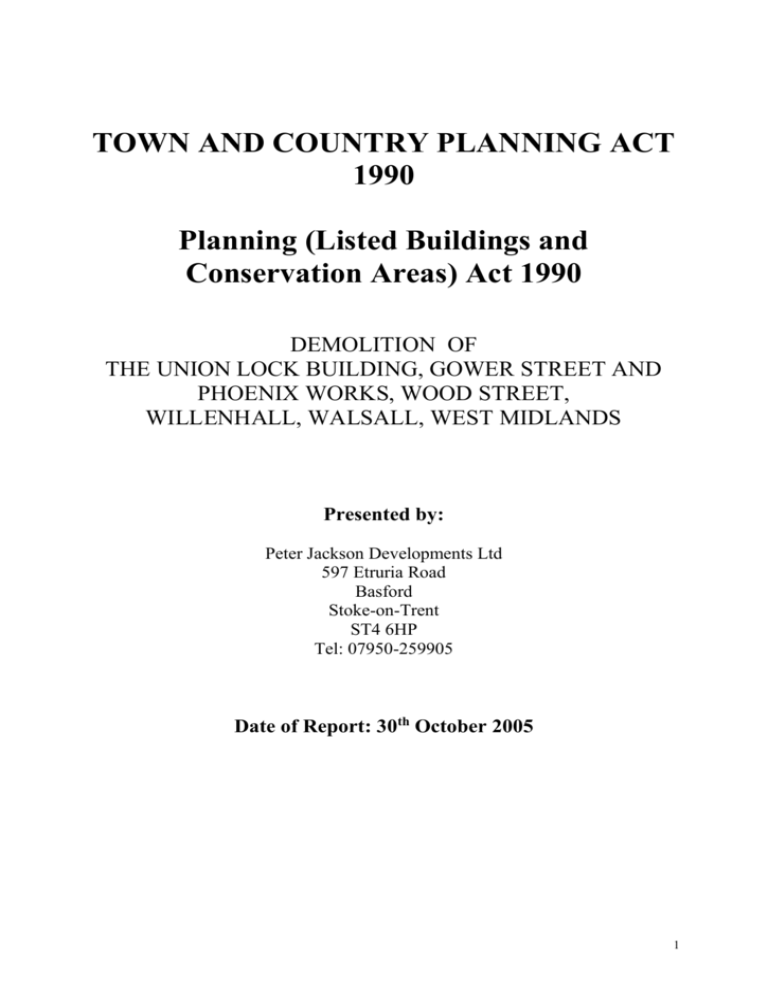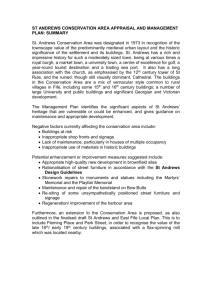Planning (Listed Buildings and Conservation Areas) Act 1990
advertisement

TOWN AND COUNTRY PLANNING ACT 1990 Planning (Listed Buildings and Conservation Areas) Act 1990 DEMOLITION OF THE UNION LOCK BUILDING, GOWER STREET AND PHOENIX WORKS, WOOD STREET, WILLENHALL, WALSALL, WEST MIDLANDS Presented by: Peter Jackson Developments Ltd 597 Etruria Road Basford Stoke-on-Trent ST4 6HP Tel: 07950-259905 Date of Report: 30th October 2005 1 CONTENTS CHAPTER 1. The application Planning Permission and Conservation Area consent 2. Willenhall Local Plan 3. Willenhall Conservation Area PPG 15 4. Josiah Parkes and Sons Ltd 5. Phoenix Works 6. Contribution of the building to the Conservation Area 7. Conclusions Appendix 1 – Listed Buildings and locally Listed Buildings Appendix 2 – Indicative Layout Plan Appendix 3 – Letter from Centro dated 24th August, 2005 Appendix 4 – Black Country Housing Study 2 1. THE APPLICATION 1.1 Peter Jackson Developments Ltd is applying for both Planning Permission and Conservation Area Consent to Walsall Metropolitan Borough Council (the LPA) for the demolition of two groups of buildings within the designated Willenhall Conservation Area, Walsall, West Midlands. 1.2 Following the approval of outline application 04/1304/OL/WZ on the 9th March 2005 for residential development it is now deemed necessary to apply for the demolition of two groups of buildings known locally as the Union Lock Works on Gower Street and the Phoenix Works 93 and 94 Wood Street, Willenhall. 1.3 Both buildings are within the Willenhall Conservation Area (see figure 1) and as such require additional consent to be demolished under the Act. 1.4 For the purposes of the application it is believed that this report should demonstrate whether “the exterior of the buildings contributes to the architectural or historic interest of any group of buildings of which it forms part.” 1.5 Extensive local research has been carried out and as such this report represents the most accurate information available on the buildings in question. 1.6 The Gower Street Union Lock Works is locally listed. 2. WILLENHALL 2.1 The town of Willenhall, Staffordshire lies midway between Walsall and Wolverhampton on the northern edge of the Black Country. Following local government reorganisation in 1974 Willenhall formed part of the Walsall Metropolitan Borough. It was an ancient settlement formed in Saxon times. In the Doomsday Book it is listed as Winehala with a population of 16. Following the discovery of coal and iron in the area manufacturing took off and Willenhall grew to become the capital of the lock making industry, producing 90% of British locks and keys. 2.2 Willenhall has not experienced extensive re-development that has affected many other settlements in the Black Country. The majority of the Town Centre and land to the east is a designated Conservation Area, however the decline in the production of locks in the area, through the amalgamation of Yale, Union and Chubb (Assa Abloy group) now means that there is no lock-making industry left in the area. 2.3 The Council recognises that there is to be a significant change in the town and edge of town centre sites mainly through housing during the local plan period however it identifies conservation as an important element in its change. 3 3. WILLENHALL CONSERVATION AREA AND PPG 15 3.1 Willenhall Conservation Area contains eight listed buildings and forty five locally listed (see appendix 1). 3.2 The designation allows general control over the demolition of unlisted buildings and provides the basis for policies designed to preserve or enhance all aspects of character and appearance that define the areas special interest. 3.3 PPG 15 indicates that it is the quality and interest of areas which should be the prime consideration in identifying Conservation Areas. It says that there has been increasing recognition in recent years that experience of a historic area depends on much more than quality of individual buildings – on the historic layout of property boundaries and thoroughfares – on a particular mix of uses – on characteristic materials – on appropriate scaling and detailing of contemporary buildings, etc. Conservation Area designation should be seen as the means of recognising the importance of all these factors and of ensuring that Conservation policy addresses the quality of townscape in its broadest sense as well as the protection of individual buildings. 3.4 It is accepted that it will often be appropriate to impose conditions for the consent of demolition to require that demolition will not take place until a contract for the carrying out of redevelopment has been made and planning permission for those works that have been granted. 3.5 In this case the replacement building has not been designed as the site is on the open market and therefore suitable conditions would need to be imposed. 4. THE UNION LOCK WORKS - JOSIAH PARKES AND SONS LTD 4.1 From evidence available it seems that the Parkes Brothers, William, Richard and Josiah set up in the ironmongery trade in about 1840 at premises 28, 29, 30 Doctors Piece. 4.2 The business grew rapidly and by 1851 William and Josiah were trading as William and Josiah Parkes Iron, Steel and Wire Merchants from Union Street. Both brothers had numerous sons and additional companies were set up by Josiah Parkes junior trading as Josiah Parkes and Sons from 18, 28, 29 and 30 Doctors Piece. Josiah Parkes and sons then bought out the Union Street business of Parkes, Parkes Co. and sold the Doctors Piece property in 1890. 4.3 By 1906 employees had totalled 35 and by 1913 they had increased to 100. 4.4 In 1930 the Union Street premises in Willenhall were modernised and a new office block on Gower Street was completed in 1933. 4 1 – Drawing 2 - Completed Building c1933 5 4.5 In 1945 work began on building a new factory covering 150,000 square feet on spare land at the company’s sports ground at Portabello. The factory started producing lock parts in 1946. 4.6 It is not clear what happened until early 2000 when Williams Holdings sold the Union factory to Assa Abloy and its closure followed. 4.7 The building follows the lines of art deco/streamline moderne (1930 – 1942). Building forms replicated trains, ocean liners, massing simplified forms with rounded corners, devoid of much applied decoration. Horizontal compositions depict bands of window glazing and flat roofs. Better examples featured glass block, steel and terrazzo facades. Streamline Moderne was a reaction to Art Deco. Gone were unnecessary ornamentation. Sharp angles were replaced with simple curves and wood and stone were replaced with concrete and glass. 3 – Express Building 6 5. PHOENIX WORKS 5.1 Very little information can be found on this building. It does not seem to have any historical connection to Willenhall. 6. WILLENHALL CONSERVATION AREA 6.1 It strikes me that there was great doubt over the designation of the Willenhall Conservation Area and indeed its locally listed buildings 4 - Stafford Street 6.2 The corner of Stafford Street shows a prime example of a row of 4 locally listed buildings showing little architectural or historic value in their contribution to the street scene or the conservation area. 5 – Stafford Street 6.3 In fact the juxtaposition of young and old buildings forms a discordant element in the street scene. 7 6 – Stafford Street 6.4 Similarly further north on Stafford Street there is no logic to the use of local listings 7 – Stafford Street 6.5 Similarly little attention has been given to the contribution those buildings could make to the town centre. 8 - Union Street 6.6 Further confusion arises on Union Street where there are derelict locally listed buildings, listed buildings (church) and unlisted buildings (the Union Lock Works, Union Street) also not included in the Conservation Area. 8 9 - Wood Street 6.7 The Conservation Area includes 3 former terraced houses on Wood Street. These have previously been converted into garage workshops and are now derelict. The former Parkes offices are now also derelict and falling into disrepair. 10 - Gower Street 6.8 Little merit exists in the retention of this building within the street scene. It has no architectural value compared to better examples of Streamline Moderne architecture in the country and is not nationally listed. 11 - Gower Street 9 6.9 Little merit exists to protect this building compared to the replacement with a contemporary residential structure. 12 - Gower Street 6.10 There is no co-ordination in the street scene to link the buildings together or to those adjoining the Conservation Area. 6.11 Whilst the buildings, one within and one outside the designated Conservation Area were built during the time of the Art Deco Streamline Moderne movement neither are fine examples. The whole emphasis was to create smooth round form with the use of colour both buildings have been painted and there is a prominent curve on the corner. There is no focal point to the design to make the structure stand out as period pieces. The construction has been carried out with a view to following streamline shape but the features are lost in the overall conglomurate of buildings surrounding and extensions. 7. CONCLUSIONS 7.1 I have demonstrated that the buildings have added little merit to the character and appearance of the Conservation area and detract from the underdeveloped site at present. Attempts have been made to dispose of the site in its current form since obtaining planning permission in January 2005 however not one single offer was made to develop the site in its present form. Conservation area consent for the demolition of the buildings would make the site more attractive to potential purchasers and therefore enabling an attractive total package to be submitted and subsequently implemented. 7.2 The buildings do not contribute to the architectural or historic interest of the site or the character and appearance of the Conservation Area. Outline planning permission has been granted for residential development. Any redevelopment would need to preserve or enhance the character and appearance of the Conservation Area. The demolition of the buildings proposed would not conflict with policies in the UDP or advice contained in PPG15. The indicative layout plan at Appendix 2 demonstrates the type of quality scheme that could be achieved. 7.3 In addition, conditions could be imposed to ensure that the demolition is not carried out until a contact for the carrying out of the works of redevelopment of the site has been 10 made and planning permission has been granted for the redevelopment for which the contract provides. This would accord with advice contained in circular 11/95 and ensure that any redevelopment preserves or enhances the character and appearance of the Conservation area. This is standard government advice given by the planning inspectorate to enable sites such as this to be redeveloped. 7.4 In addition, any environmental improvements in the vicinity of any future metro scheme would positively contribute to the public perception of the area as a whole. Centro anticipate that any route would be aligned with 250m of the site (see Appendix 3). 11









